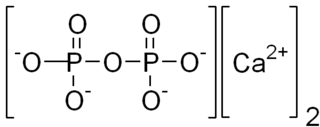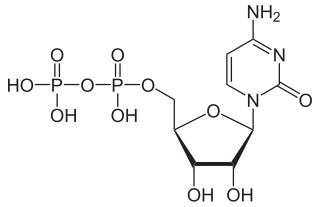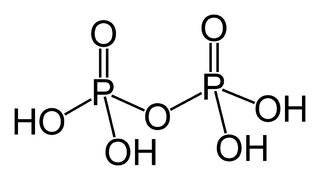 W
WIn chemistry, pyrophosphates are phosphorus oxyanions that contain two phosphorus atoms in a P-O-P linkage. A number of pyrophosphate salts exist, such as Na2H2P2O7. Often pyrophosphates are called diphosphates. The parent pyrophosphates are derived from partial or complete neutralization of pyrophosphoric acid. Important salts include disodium pyrophosphate and tetrasodium pyrophosphate. The pyrophosphate bond is also sometimes referred to as a phosphoanhydride bond, a naming convention which emphasizes the loss of water that occurs when two phosphates form a new P-O-P bond, and which mirrors the nomenclature for anhydrides of carboxylic acids. Pyrophosphates are found in ATP and other nucleotide triphosphates, which are very important in biochemistry.
 W
WAdenosine diphosphate (ADP), also known as adenosine pyrophosphate (APP), is an important organic compound in metabolism and is essential to the flow of energy in living cells. ADP consists of three important structural components: a sugar backbone attached to adenine and two phosphate groups bonded to the 5 carbon atom of ribose. The diphosphate group of ADP is attached to the 5’ carbon of the sugar backbone, while the Adenine attaches to the 1’ carbon.
 W
WCalcium pyrophosphate (Ca2P2O7) is a chemical compound, an insoluble calcium salt containing the pyrophosphate anion. There are a number of forms reported: an anhydrous form, a dihydrate, Ca2P2O7·2H2O and a tetrahydrate, Ca2P2O7·4H2O. Deposition of dihydrate crystals in cartilage are responsible for the severe joint pain in cases of calcium pyrophosphate deposition disease (pseudo gout) whose symptoms are similar to those of gout. Ca2P2O7 is commonly used as a mild abrasive agent in toothpastes, because of its insolubility and nonreactivity toward fluoride.
 W
WCytidine diphosphate, abbreviated CDP, is a nucleoside diphosphate. It is an ester of pyrophosphoric acid with the nucleoside cytidine. CDP consists of the pyrophosphate group, the pentose sugar ribose, and the nucleobase cytosine.
 W
WDeoxyadenosine diphosphate is a nucleoside diphosphate. It is related to the common nucleic acid ATP, or adenosine triphosphate, with the -OH (hydroxyl) group on the 2' carbon on the nucleotide's pentose removed, and with one fewer phosphoryl group than ATP. This makes it also similar to adenosine diphosphate except with a hydroxyl group removed.
 W
WDeoxycytidine diphosphate is a nucleoside diphosphate. It is related to the common nucleic acid CTP, or cytidine triphosphate, with the -OH (hydroxyl) group on the 2' carbon on the nucleotide's pentose removed, and with one fewer phosphoryl group than CTP.
 W
WDeoxyguanosine diphosphate (dGDP) is a nucleoside diphosphate. It is related to the common nucleic acid guanosine triphosphate (GTP), with the -OH group on the 2' carbon on the nucleotide's pentose removed, and with one fewer phosphoryl group than GTP.
 W
WDisodium pyrophosphate or sodium acid pyrophosphate (SAPP) is an inorganic compound consisting of sodium cations and pyrophosphate anion. It is a white, water-soluble solid that serves as a buffering and chelating agent, with many applications in the food industry. When crystallized from water, it forms a hexahydrate, but it dehydrates above room temperature. Pyrophosphate is a polyvalent anion with a high affinity for polyvalent cations, e.g. Ca2+.
 W
WGuanosine diphosphate, abbreviated GDP, is a nucleoside diphosphate. It is an ester of pyrophosphoric acid with the nucleoside guanosine. GDP consists of a pyrophosphate group, a pentose sugar ribose, and the nucleobase guanine.
 W
WIron(III) pyrophosphate is an inorganic chemical compound with the formula Fe4(P2O7)3.
 W
WManganese violet is the common name for ammonium manganese(III) pyrophosphate, an inorganic compound composed of ammonium, manganese in the +3 oxidation state, and the pyrophosphate anion. It is prepared by heating a mixture of manganese(III) oxide, diammonium phosphate, and phosphoric acid. This material is a popular inorganic pigment.
 W
WA phosphoric acid, in the general sense, is a phosphorus oxoacid in which each phosphorus atom is in the oxidation state +5, and is bonded to four oxygen atoms, one of them through a double bond, arranged as the corners of a tetrahedron. Two or more of these PO4 tetrahedra may be connected by shared single-bonded oxygens, forming linear or branched chains, cycles, or more complex structures. The single-bonded oxygen atoms that are not shared are completed with acidic hydrogen atoms. The general formula of a phosphoric acid is Hn+2−2xPnO3n+1−x, where n is the number of phosphorus atoms and x is the number of fundamental cycles in the molecule's structure, between 0 and (n+2)/2.
 W
WA phosphorimidazolide is a chemical compound in which a phosphoryl mono-ester is covalently bound to a nitrogen atom in an imidazole ring. They are a type of phosphoramidate. These phosphorus (V) compounds are encountered as reagents used for making new phosphoanhydride bonds with phosphate mono-esters, and as reactive intermediates in phosphoryl transfer reactions in some enzyme-catalyzed transformations. They are also being studied as critical chemical intermediates for the polymerization of nucleotides in pre-biotic settings. They are sometimes referred to as phosphorimidazolidates, imidazole-activated phosphoryl groups, and P-imidazolides.
 W
WTetraethyl pyrophosphate, abbreviated TEPP, is an organophosphate compound with the formula [(C2H5O)2P(O)]2O. It is the tetraethyl derivative of pyrophosphate (P2O74-). It is a colorless oil that solidifies near room temperature. It is used as an insecticide. The compound hydrolyzes rapidly.
 W
WTetrasodium pyrophosphate, also called sodium pyrophosphate, tetrasodium phosphate or TSPP, is an inorganic compound with the formula Na4P2O7. As a salt, it is a white, water-soluble solid. It is composed of pyrophosphate anion and sodium ions. Toxicity is approximately twice that of table salt when ingested orally. Also known is the decahydrate Na4P2O7 · 10(H2O).
 W
WThiamine pyrophosphate (TPP or ThPP), or thiamine diphosphate (ThDP), or cocarboxylase is a thiamine (vitamin B1) derivative which is produced by the enzyme thiamine diphosphokinase. Thiamine pyrophosphate is a cofactor that is present in all living systems, in which it catalyzes several biochemical reactions.
 W
WThymidine diphosphate (TDP) or deoxythymidine diphosphate (dTDP) is a nucleotide diphosphate. It is an ester of pyrophosphoric acid with the nucleoside thymidine. dTDP consists of the pyrophosphate group, the pentose sugar ribose, and the nucleobase thymine. Unlike the other deoxyribonucleotides, thymidine diphosphate does not always contain the "deoxy" prefix in its name.
 W
WUridine diphosphate, abbreviated UDP, is a nucleotide diphosphate. It is an ester of pyrophosphoric acid with the nucleoside uridine. UDP consists of the pyrophosphate group, the pentose sugar ribose, and the nucleobase uracil.
 W
WZinc pyrophosphate (Zn2P2O7) is an ionic inorganic chemical compound composed of Zn2+ cations and pyrophosphate anions. It is useful in gravimetric analysis of zinc. Zinc pyrophosphate is obtained by precipitating zinc as a phosphate, then heating over 1123 K.